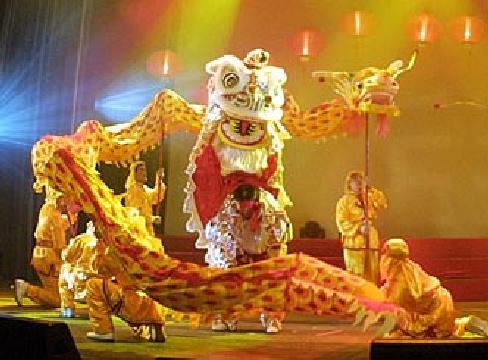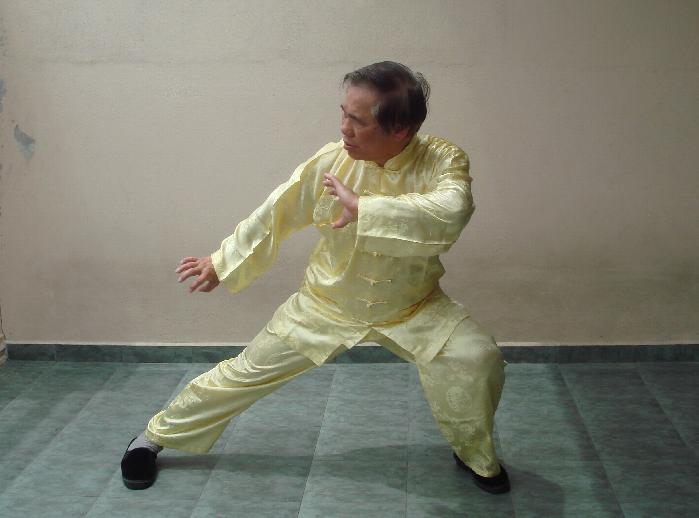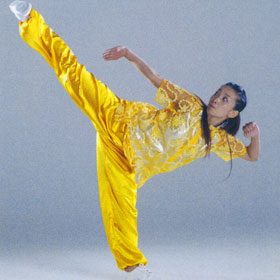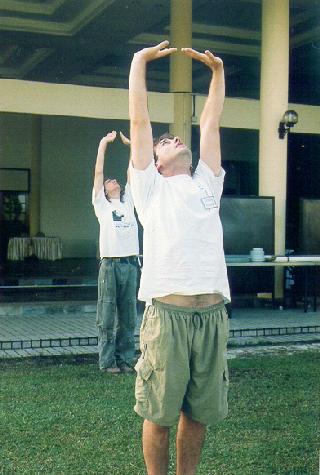February 2008 (Part 1)
SELECTION OF QUESTIONS AND ANSWERS

A Prosperous Chinese New Year

Grandmaster Wong demonstrating a pattern from traditional kungfu
Question 1
I guess in the past I was looking for the forms of Shaolin Kung Ku with the flying kicks and a body that could not get hit. But I now realize that there is so much more than showmanship.
— Nicholas, Holland
Answer
I am glad you realize this important point, which will make a huge difference in your life. While combat efficiency is desirable, in today's generally law-abiding society, good health, vitality and longevity are the more important benefits we get from practicing Shaolin Kungfu.
At higher levels, practicing Shaolin Kungfu gives us mind expansion and spiritual joys. Training diligently everyday just to perform beautiful forms to please spectators is a poor use of time.
But todoay Shaolin Kungfu as well as other styles of kungfu and martial arts have been badly debased. Not only most practitioners cannot defend themselves, they become less healthy as a result of their training!
Their inability to defend themselves is evident in the fact that they are routinely being hit in free sparring. Their becoming less healthy is evident in the fact that they become aggressive and in pain more often after they started training than before.
Question 2
Nevertheless, I still want to learn traditional Shaolin Kung Fu.
Answer
If we accept the fact that genuine, traditional Shaolin Kungfu gives practitioners combat efficiency, internal force and spiritual cultivation, then it is very rare today. At the risk of being called egoistic or boastful, we are proud that that is what we practice, and those are the benefits we have.
If we are contented that Shaolin Kungfu is defined by its exteranl forms or by its lineage tracing back to the Shaolin Temple in the past, then Shaolin Kungfu is plentiful.
Question 3
I would love to meet you when I visit China. Where is your school?
Answer
Although I am Chinese, I don't live in China; I live in Malaysia. Had I lived in China, I would not be able to inherit the genuine, traditional Shaolin Kungfu that I practice and teach. The Shaolin Kungfu that we practice in Shaolin Wahnam was brought out of the Shaolin Temple and transmitted outside of China.
When the present Chinese government took over control in China in 1949, traditional arts like kungfu, chi kung, meditation, painting, music and poetry were considered bourgeois, and therefore counter-revolutionary. During the Cultural Revolution in the 1960s, being counter-revolutionary was the greatest crime in China, and would be destroyed by the notorious Red Guards. Hence, genuine traditional Shaolin Kungfu disappeared in China during those times. But there was a policy change when the great Chinese leader, Deng Xiao Ping, regained power.
Kungfu masters who kept their arts in secret for fear of prosecution were invited to formulate a modern form of wushu from traditional forms. Modern wushu, however, has been taught as a sport and not as a martial art. Combat application, internal force and spiritual cultivation — the very three aspects that make Shaolin Kungfu great — are not included in modern wushu.
Some traditional masters opposed modern wushu. Initially there was a contest for influence between kungfu traditionalists and wushu modernists in China. The government supported and promoted wushu, which eventually won overwhelmingly. Today, traditional kungfu is very rarely found in China.
My school is found all over the world — in Asia, Europe, North America, South America, Australia and Africa. We probably have the widest spread in kungfu history. You can find our List of Certified Instructors at /general/instructors-list.html.

A magnificient high kick by a young wushu performer. But such high kicks are taboos in traditional kungfu as some vital parts are dangerously exposed.
Question 4
I'm very grateful for your help, and to know that there is someone out there who will tell me what I want to know about this martial art.
Answer
We in Shaolin Wahnam have benefited greatly from our Shaolin Kungfu training, which has given us combat efficiency, good health, vitality, longevity, mental clarity and spiritual joys. We are keenly awared that Shaolin Kungfu has been transformed to such an extent that what is generally practiced as Shaolin Kungfu now is vastly different from what it was traditionally practiced in the past.
In the past, stances were very important. Shaolin practitioners had internal force and used Shaolin patterns for combat. They were relaxed and peaceful even under demanding situations. Size, age and sex were not decisive factors in combat as well as daily performance. For example, a diminitive woman of 60 could defeat a muscular young man of 30 in combat, or perform better than him in daily activities.
Today, amongst most modern Shaolin practitioners, stances are not important. They use muscular strength and Kick-Boxing for combat. They are tensed and agitated even in ordinary situations. Size, age and sex are decisive factors in combat as well as daily performance. Regardless of how beautiful her forms are and for how many years she has trained, it would be impossibe for a diminitve woman of 60 to defeat a muscular young man of 30 in combat, or perform better than him in daily activities.
We practice the traditional form of Shaolin Kungfu and derive the exact benefits that practicing Shaolin Kungfu is purportoed to give us. While we respect the right of others to practice Shaolin Kungfu in its modern form or in whatever ways they like, we feel duty bound to preserve traditional Shaolin Kungfu and help others who sincerely seek our advice. As part of our on-going effort to help preserve genuine, traditional Shaolin Kungfu, we have publicly shared secrets that many masters in the past would keep only for their top students.
Question 5
But I keep seeing those monks. If the Shaolin Temple was destroyed, where do they practice Shaolin Kung Fu?
Answer
There were three Shaolin Temples — one in the north in Henan Province, and two in the south in Fujian Province. The southern Shaolin Temple in Quanzhou City was public. It was built in the Ming Dynasty by imperial degree. The one on Nine-Lotus Mountain was secret. It was built by the Venerable Chee Seen.
When one talks about the burning of the Shaolin Temple in kungfu context, many people mistakenly think it was the northern Henan temple. Actually it was the two southern temples in Fujian. The public Quanzhou Shaolin Temple was burnt in the 1850s by the Qing Army with the help of Lama kungfu experts from Tibet. The Venerable Chee Seen was amongst a few monks who escaped. Another monk who escaped was the Venerable Jiang Nan.
The Venerable Chee Seen built another southern Shaolin Temple in secret on the Nine-Lotus Mountain. A few years later this temple was also burnt by the Qing Army, this time led by Pak Mei who was an elder kungfu brother of Chee Seen.
The northern Shaolin Temple in Henan remained throughout the Qing Dynasty. But its importance as the Imperial Temple for the Chinese empire had long been shifted to the southern Shaolin Temple at Quanzhou during the Ming Dynasty. The Qing emperors builded another Imperial Temple in Bejing during their time, called the Yong He Temple, which was modelled after the Lhasa Temple in Tibet.
The northern Shaolin Temple was deserted. 17 years after the fall of the Qing Dynasty, a warlord used it as a military camp. A rival warlord burned it in 1928 using guns and cannons. This burning of the northern Shaolin Temple had nothing to do with kungfu.
Half a century later, after the world-wide success of Jet Li's movie, “The Shaolin Temple”, the Chinese government renovated this deserted northern Shaolin Temple. It became a very popular tourist attraction. Neither kungfu nor modern wushu was practiced there. But many wushu schools mashroomed around the temple.
I don't know where the modern Shaolin monks practice Shaolin Kungfu nowadays, or learned Shaolin Kungfu after the restoration of the modern Henan Shaolin Temple. It is best to ask them. But I am sure the Shaolin Kungfu they practice is very different from the Shaolin Kungfu practiced both inside and outside the Shaolin Temple in the past.
In mainland China, kungfu is called “wushu”. What was taught in the numerous wushu schools around the Shaolin Temple was not Shaolin Wushu or Shaolin Kungfu, but just wushu. The wushu practiced here was the same as the wushu practiced anywhere else in China.
Question 6
I have been reading your webpages and your books for over 2 years now, and through them I now have an understanding of what genuine Shaolin Kung Fu and chi kung are. With the advice of your books and webpages I have found a genuine Kung Fu and chi kung master.
The way this master teaches is the way you describe how a genuine kung fu master teaches, namely internal force training, form, sparring methodically, and most importantly combat application.
The point of my email is to ask for your invaluable advice so I can get the most out of my training — advice on things like the do's and dont's.
I would like to thank you for all the invaluable information you have kindly published on the Shaolin arts, information that would have been impossible for most people to acquire in the past.
— Nawi, New Zealand
Answer
Congratulations for being able to learn from a genuine master. It is a rare opportunity, so treasure it.
Good advice on how you should respect your master, and what you should do to get the best benefits can be found in the following webpages /general/respect.html and /general/benefits.html. One thing that would make a master chase a student away is when the student tries to be smarter than him. Let us take an example of Iron Palm training.
The master tells a student to strike a sandbag in a relaxed manner. Instead of following the instruction faithfully, the student asks whether he could strike the sandbag with some force.
“No, strike the bag in a relaxed manner,” the master says again. The student, trying to be smart, asks, “Wouldn't my strike be stronger if I strike with some force?”
The master is visibly annoyed, but still keeps his patience and repeats, “Strike the bag in a relaxed manner!”
The student, trying to be smarter than the master, says, “How can you break a brick if you don't strike with force?”
What do you think the master would do?

Shaolin Wahnam students performing "Lifting the Sky" at an Intensive Chi Kung Course
Question 7
I have been performing “Lifting The Sky”, “Carrying the Moon” and Standing Meditation. Do I need to perform these in a particular sequence? Can I incorporate other exercises in your book with these? Must I perform the three exercises above first and then other exercises?
— Robert, USA
Answer
Yes, you can perform the exercises in any sequence, although Standing Meditation is normally performed at the end, and you can incorporate other exercises from my books or from other sources. In other words, these exercises can be perform one at a time, or in any combination, including performing Standing Meditation at the beginning or in the middle, and combing them with any other exercises.
I would like to share with you a simple but great secret. The exercises are techniques. They are means, and not ends by themselves. They are meant to generate an internal energy flow. It is the energy flow that gives practitioners good health, vitality and longevity.
More than 80% of people who practice chi kung, including in China today, do not realize this secret. Without being conscious of it, they regard the exercises as ends by themselves. They measure their progress by the number of exercises they know, or by how beautifully they perform the exercises, or by long they have practiced the exercises. They do not measure their progress by how healthy or full of vitality they are as a result of practicing the exercises.
Let us take an example. Tom, Dick and Harry were initially weak and sick. They practice “Lifting the Sky”, “Carrying the Moon”, and “Standing Meditation”. Tom has practiced these exercises for 10 years, Dick has practiced them for 5 years but he also knows and practices 20 other chi kung exercises, whereas Harry has practiced the three exercises for a year. Tom and Dick are still weak and sick, but Harry is healthy and full of vitality.
We in Shaolin Wahnam have no doubt that Harry is the most advanced, although he has only spent a year in chi kung whereas the other two have spent 5 and 10. After I have highlighted the fact that Harry has benefitted from his chi kung training whereas the other two haven't, some people may revise their earlier opinion. But I am quite sure that before this fact is highlighted, many people would vote Tom or Dick as most advanced.
Question 8
I read about “wu wei” in many books on Taoism. Most authors translate it as “no action” or “non action”. They also say that by doing no action, everything will be done. I find that does not make any sense. Is “wu wei” found in your arts? Can you please explain this to us?
— Robert, UK
Answer
“Wu wei” is a very important concept and practice in Taoism as well as in many arts of energy and of spiritual cultivation. Literally it means “no action” or “non action”. But a better term, I believe, is “spontaneity” or “naturalness”.
You are right. A popular explanation of “wu wei” is that if one does nothing, then everything will be done for him, which is the core of Taoist teaching. You are also right to say that this explanation does not make any sense. How can everything be accomplished when one does not do anything?
The confusion arises because many people, including Western authors who translate the term and explanation directly from Chinese sources, do not know that this is only half the secret. In general, Taoist masters were conservative. They would be generous if they gave you half the secret, often hidden in flowery language.
The other half of the secret is “you wei”, which literally means “there is action”. Actually, it is not just action, but correct action. First, there is “you wei”, then there is “wu wei”. First, you perform the correct action, then you be natural and reap the benefits that action is purported to give.
In our chi kung practice we have a lot of occasions to experience and benefit from “you wei” and “wu wei”. Suppose a practitioner has diabetes. He performs some appropriate chi kung exercises. This is the “you wei” part. Then he lets go and enjoy “wu wei”, i.e. he does nothing. If his chi flow moves him to the right, he does not tense his muscles to stop the movement. If the chi flow pushes him onto the ground, he does not resist it. After a few months, his doctors are surprised that he no longer suffers from diabetes.
Take another example. A student has no obvious illness, but he often feels weak and tired. He performs his chi kung exercises, then he lets go and does nothing. He does not move vigorously in his chi flow, but he just stands flowingly still and enjoys himself. After a few months, he finds himself in good health and vitality. He too benefit from “wu wei”.
Suppose the first student attempts to be smarter than his teacher who asks him to follow “wu wei”. He has read that diabetes is due to the inability of the patient to digest sugar. He also has read that it is the insulin produced in the pancreas that digests the sugar. So he tries to direct his chi to his pancreas, instead of following the movement of his chi flow. This is not “wu wei”. Not only he may not recover from his diabetes, he may create other problems.
Let us look at the second example. The second student also tries to be too smart. He thinks that he should have chi flow, the more vigorous the better, and not merely standing flowingly still. So he tries to move his body. This is also not following “wu wei”. He may become weaker and more tired, and may develop some serious health problems.
Why is this so? Why is it that after performing the appropriate chi kung exercises, i.e. the “you wei” part, by being spontaneous or natural, i.e. the “wu wei” part, the two students get the best benefits. In the case of the first student, the problem may not be at the pancreas. By being spontaneous the first student allows the chi to flow to where the energy blockage is and restore harmonious chi flow. In the case of the second student, his heart is weak. By being spontaneous he allows the chi to work on his heart to strengthen it.
How does chi know where to flow to or what to do when the students, their doctors and their chi kung teacher do not know where or what the problems are? It is the natural characteristic of chi to flow to where the problems are and overcome them.
It is like asking why you can quench your thirst when you drink some water. You need not know where in your body is the thirst located or how water can quench thirst. It is the natural characteristic of water to do so.
LINKS
Selected Reading
- Can the Tiger Claw be used against any Grappling Attacks?
- Is there Further Training after an Intensive Course?
- Felling an Opponent Without him Realizing What has Happened
- Bringing Purpose to my Life and Life to my Purpose
- Breathing Methods and Control in Taijiquan
